Training for Community Health Workers
VerifiedAdded on 2022/08/20
|5
|926
|10
AI Summary
Contribute Materials
Your contribution can guide someone’s learning journey. Share your
documents today.
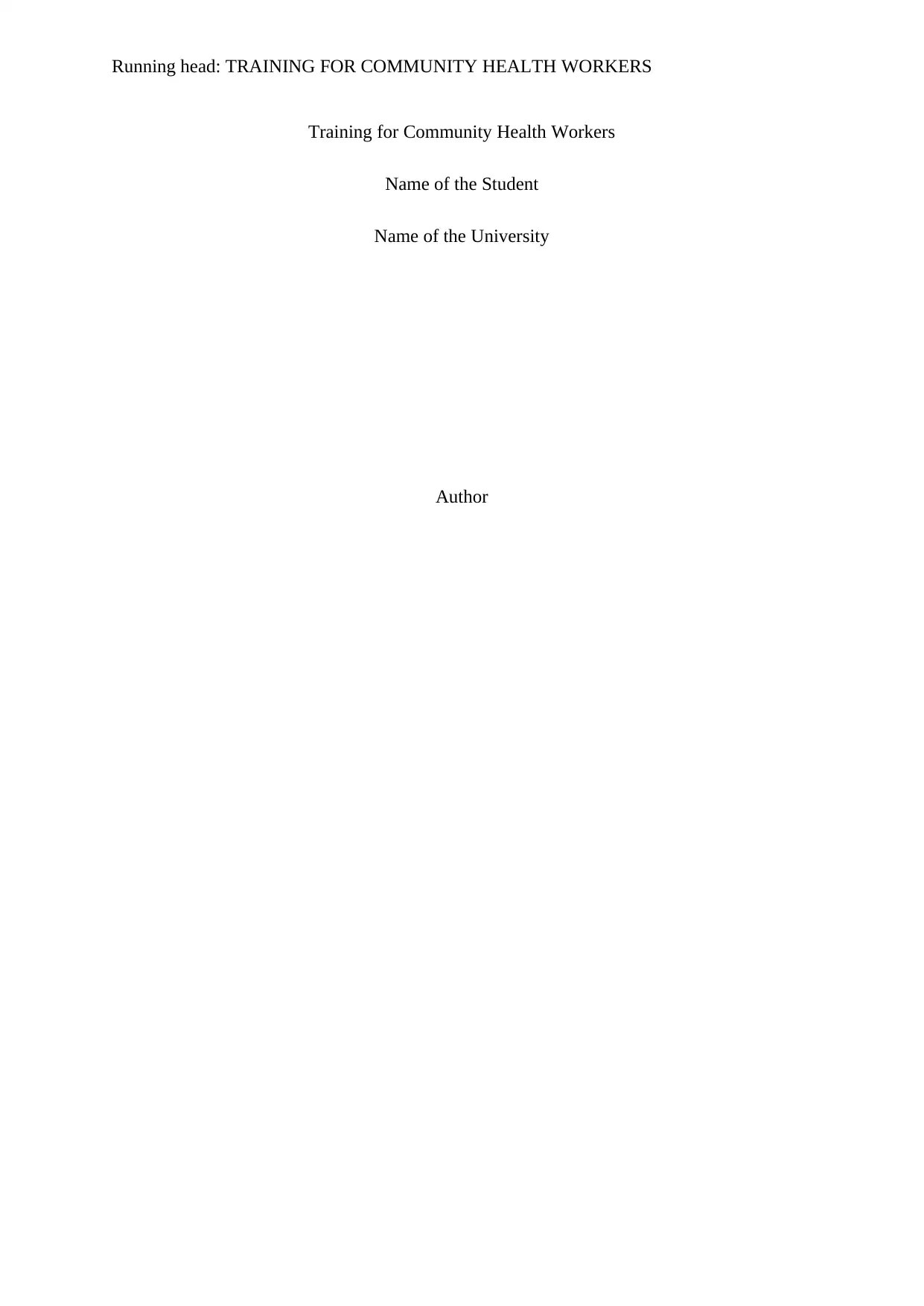
Running head: TRAINING FOR COMMUNITY HEALTH WORKERS
Training for Community Health Workers
Name of the Student
Name of the University
Author
Training for Community Health Workers
Name of the Student
Name of the University
Author
Secure Best Marks with AI Grader
Need help grading? Try our AI Grader for instant feedback on your assignments.
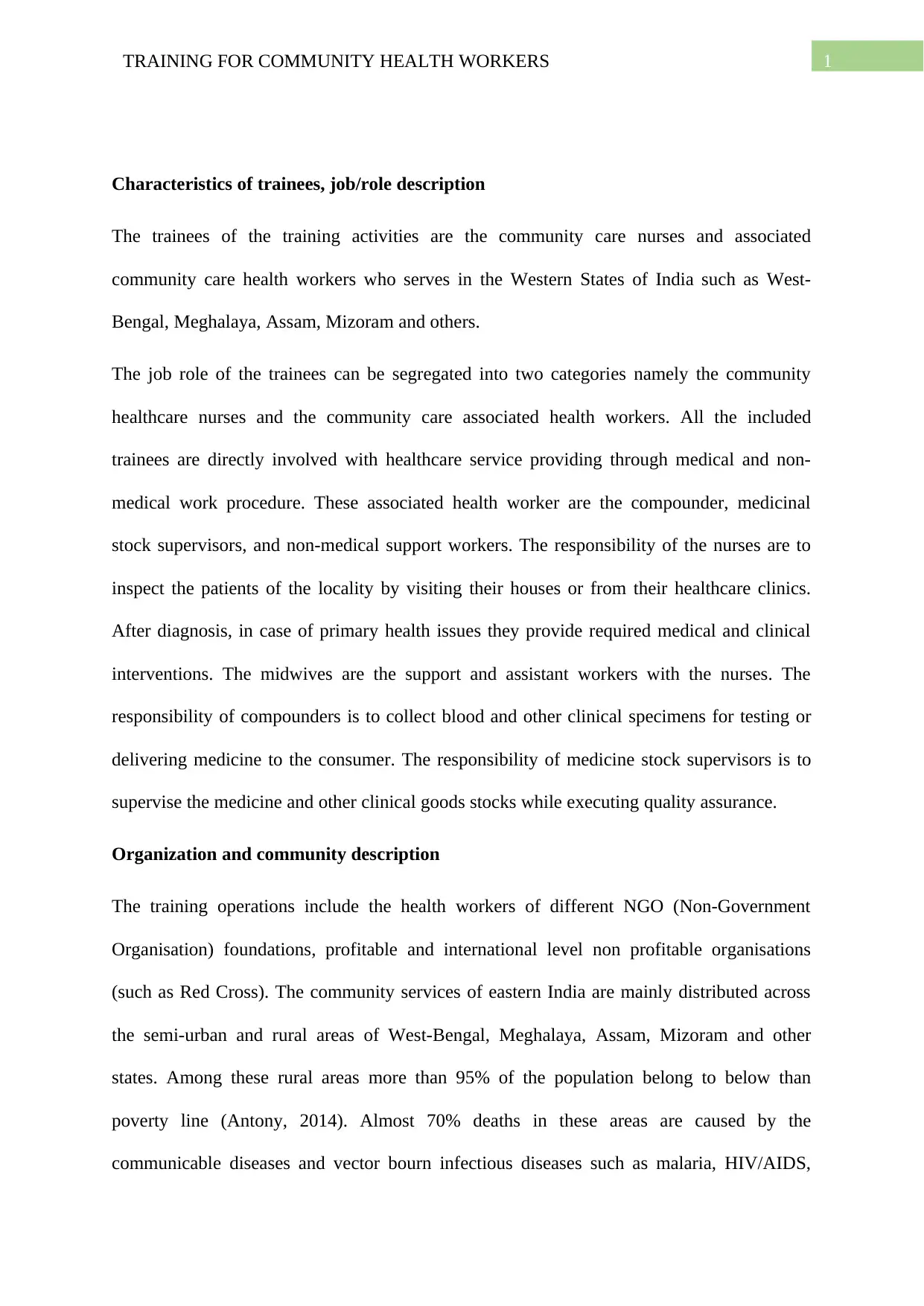
1TRAINING FOR COMMUNITY HEALTH WORKERS
Characteristics of trainees, job/role description
The trainees of the training activities are the community care nurses and associated
community care health workers who serves in the Western States of India such as West-
Bengal, Meghalaya, Assam, Mizoram and others.
The job role of the trainees can be segregated into two categories namely the community
healthcare nurses and the community care associated health workers. All the included
trainees are directly involved with healthcare service providing through medical and non-
medical work procedure. These associated health worker are the compounder, medicinal
stock supervisors, and non-medical support workers. The responsibility of the nurses are to
inspect the patients of the locality by visiting their houses or from their healthcare clinics.
After diagnosis, in case of primary health issues they provide required medical and clinical
interventions. The midwives are the support and assistant workers with the nurses. The
responsibility of compounders is to collect blood and other clinical specimens for testing or
delivering medicine to the consumer. The responsibility of medicine stock supervisors is to
supervise the medicine and other clinical goods stocks while executing quality assurance.
Organization and community description
The training operations include the health workers of different NGO (Non-Government
Organisation) foundations, profitable and international level non profitable organisations
(such as Red Cross). The community services of eastern India are mainly distributed across
the semi-urban and rural areas of West-Bengal, Meghalaya, Assam, Mizoram and other
states. Among these rural areas more than 95% of the population belong to below than
poverty line (Antony, 2014). Almost 70% deaths in these areas are caused by the
communicable diseases and vector bourn infectious diseases such as malaria, HIV/AIDS,
Characteristics of trainees, job/role description
The trainees of the training activities are the community care nurses and associated
community care health workers who serves in the Western States of India such as West-
Bengal, Meghalaya, Assam, Mizoram and others.
The job role of the trainees can be segregated into two categories namely the community
healthcare nurses and the community care associated health workers. All the included
trainees are directly involved with healthcare service providing through medical and non-
medical work procedure. These associated health worker are the compounder, medicinal
stock supervisors, and non-medical support workers. The responsibility of the nurses are to
inspect the patients of the locality by visiting their houses or from their healthcare clinics.
After diagnosis, in case of primary health issues they provide required medical and clinical
interventions. The midwives are the support and assistant workers with the nurses. The
responsibility of compounders is to collect blood and other clinical specimens for testing or
delivering medicine to the consumer. The responsibility of medicine stock supervisors is to
supervise the medicine and other clinical goods stocks while executing quality assurance.
Organization and community description
The training operations include the health workers of different NGO (Non-Government
Organisation) foundations, profitable and international level non profitable organisations
(such as Red Cross). The community services of eastern India are mainly distributed across
the semi-urban and rural areas of West-Bengal, Meghalaya, Assam, Mizoram and other
states. Among these rural areas more than 95% of the population belong to below than
poverty line (Antony, 2014). Almost 70% deaths in these areas are caused by the
communicable diseases and vector bourn infectious diseases such as malaria, HIV/AIDS,
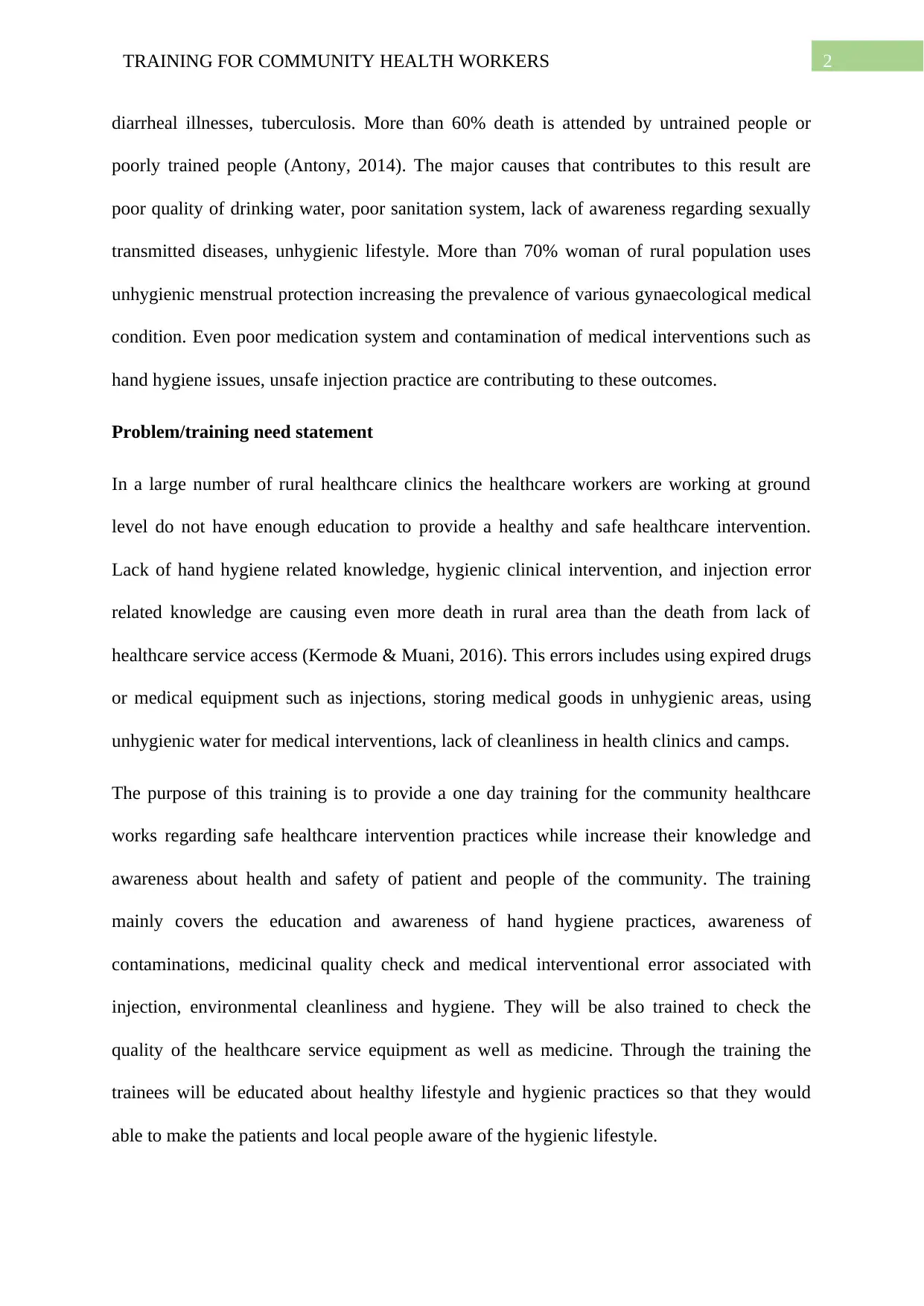
2TRAINING FOR COMMUNITY HEALTH WORKERS
diarrheal illnesses, tuberculosis. More than 60% death is attended by untrained people or
poorly trained people (Antony, 2014). The major causes that contributes to this result are
poor quality of drinking water, poor sanitation system, lack of awareness regarding sexually
transmitted diseases, unhygienic lifestyle. More than 70% woman of rural population uses
unhygienic menstrual protection increasing the prevalence of various gynaecological medical
condition. Even poor medication system and contamination of medical interventions such as
hand hygiene issues, unsafe injection practice are contributing to these outcomes.
Problem/training need statement
In a large number of rural healthcare clinics the healthcare workers are working at ground
level do not have enough education to provide a healthy and safe healthcare intervention.
Lack of hand hygiene related knowledge, hygienic clinical intervention, and injection error
related knowledge are causing even more death in rural area than the death from lack of
healthcare service access (Kermode & Muani, 2016). This errors includes using expired drugs
or medical equipment such as injections, storing medical goods in unhygienic areas, using
unhygienic water for medical interventions, lack of cleanliness in health clinics and camps.
The purpose of this training is to provide a one day training for the community healthcare
works regarding safe healthcare intervention practices while increase their knowledge and
awareness about health and safety of patient and people of the community. The training
mainly covers the education and awareness of hand hygiene practices, awareness of
contaminations, medicinal quality check and medical interventional error associated with
injection, environmental cleanliness and hygiene. They will be also trained to check the
quality of the healthcare service equipment as well as medicine. Through the training the
trainees will be educated about healthy lifestyle and hygienic practices so that they would
able to make the patients and local people aware of the hygienic lifestyle.
diarrheal illnesses, tuberculosis. More than 60% death is attended by untrained people or
poorly trained people (Antony, 2014). The major causes that contributes to this result are
poor quality of drinking water, poor sanitation system, lack of awareness regarding sexually
transmitted diseases, unhygienic lifestyle. More than 70% woman of rural population uses
unhygienic menstrual protection increasing the prevalence of various gynaecological medical
condition. Even poor medication system and contamination of medical interventions such as
hand hygiene issues, unsafe injection practice are contributing to these outcomes.
Problem/training need statement
In a large number of rural healthcare clinics the healthcare workers are working at ground
level do not have enough education to provide a healthy and safe healthcare intervention.
Lack of hand hygiene related knowledge, hygienic clinical intervention, and injection error
related knowledge are causing even more death in rural area than the death from lack of
healthcare service access (Kermode & Muani, 2016). This errors includes using expired drugs
or medical equipment such as injections, storing medical goods in unhygienic areas, using
unhygienic water for medical interventions, lack of cleanliness in health clinics and camps.
The purpose of this training is to provide a one day training for the community healthcare
works regarding safe healthcare intervention practices while increase their knowledge and
awareness about health and safety of patient and people of the community. The training
mainly covers the education and awareness of hand hygiene practices, awareness of
contaminations, medicinal quality check and medical interventional error associated with
injection, environmental cleanliness and hygiene. They will be also trained to check the
quality of the healthcare service equipment as well as medicine. Through the training the
trainees will be educated about healthy lifestyle and hygienic practices so that they would
able to make the patients and local people aware of the hygienic lifestyle.
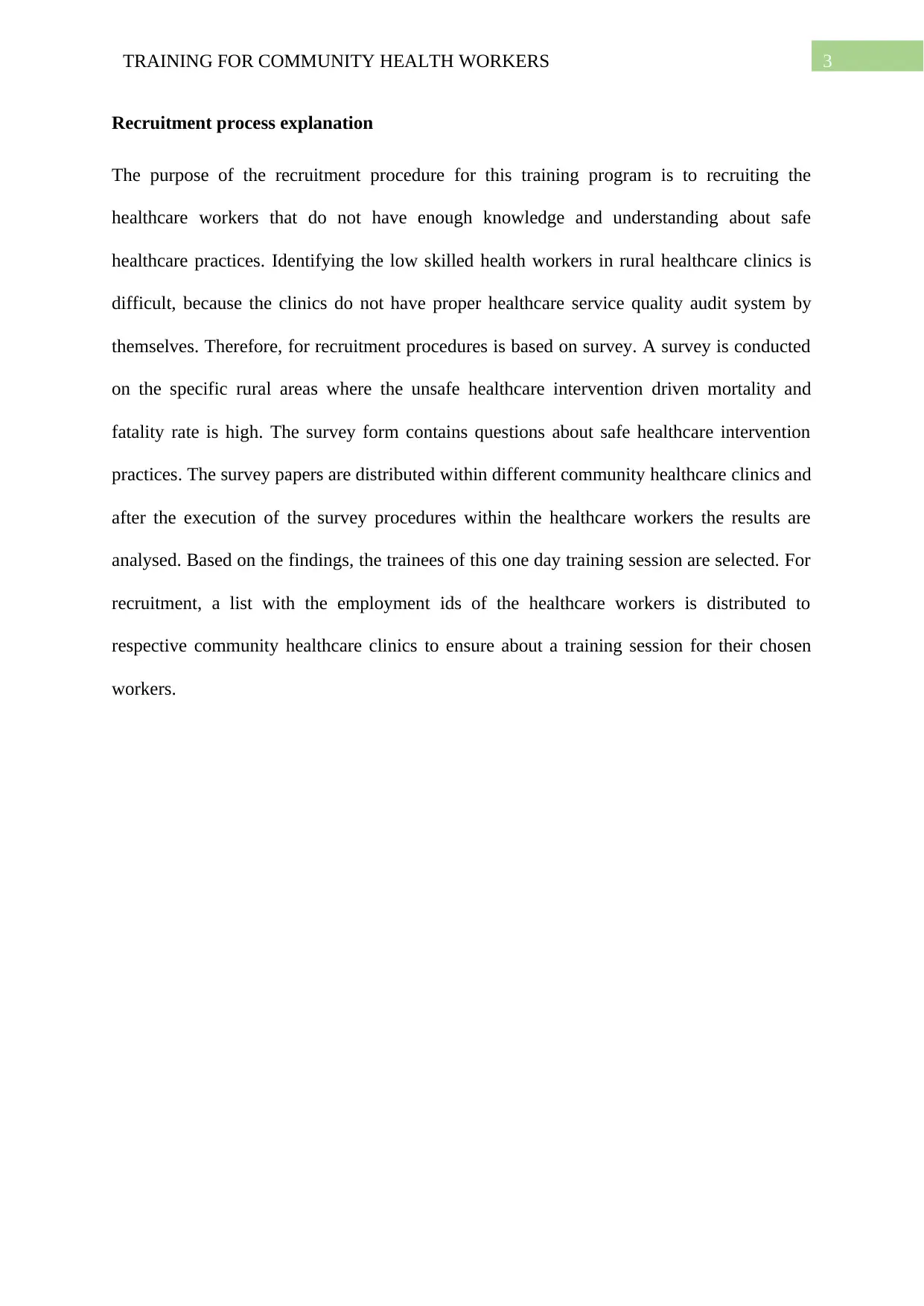
3TRAINING FOR COMMUNITY HEALTH WORKERS
Recruitment process explanation
The purpose of the recruitment procedure for this training program is to recruiting the
healthcare workers that do not have enough knowledge and understanding about safe
healthcare practices. Identifying the low skilled health workers in rural healthcare clinics is
difficult, because the clinics do not have proper healthcare service quality audit system by
themselves. Therefore, for recruitment procedures is based on survey. A survey is conducted
on the specific rural areas where the unsafe healthcare intervention driven mortality and
fatality rate is high. The survey form contains questions about safe healthcare intervention
practices. The survey papers are distributed within different community healthcare clinics and
after the execution of the survey procedures within the healthcare workers the results are
analysed. Based on the findings, the trainees of this one day training session are selected. For
recruitment, a list with the employment ids of the healthcare workers is distributed to
respective community healthcare clinics to ensure about a training session for their chosen
workers.
Recruitment process explanation
The purpose of the recruitment procedure for this training program is to recruiting the
healthcare workers that do not have enough knowledge and understanding about safe
healthcare practices. Identifying the low skilled health workers in rural healthcare clinics is
difficult, because the clinics do not have proper healthcare service quality audit system by
themselves. Therefore, for recruitment procedures is based on survey. A survey is conducted
on the specific rural areas where the unsafe healthcare intervention driven mortality and
fatality rate is high. The survey form contains questions about safe healthcare intervention
practices. The survey papers are distributed within different community healthcare clinics and
after the execution of the survey procedures within the healthcare workers the results are
analysed. Based on the findings, the trainees of this one day training session are selected. For
recruitment, a list with the employment ids of the healthcare workers is distributed to
respective community healthcare clinics to ensure about a training session for their chosen
workers.
Secure Best Marks with AI Grader
Need help grading? Try our AI Grader for instant feedback on your assignments.
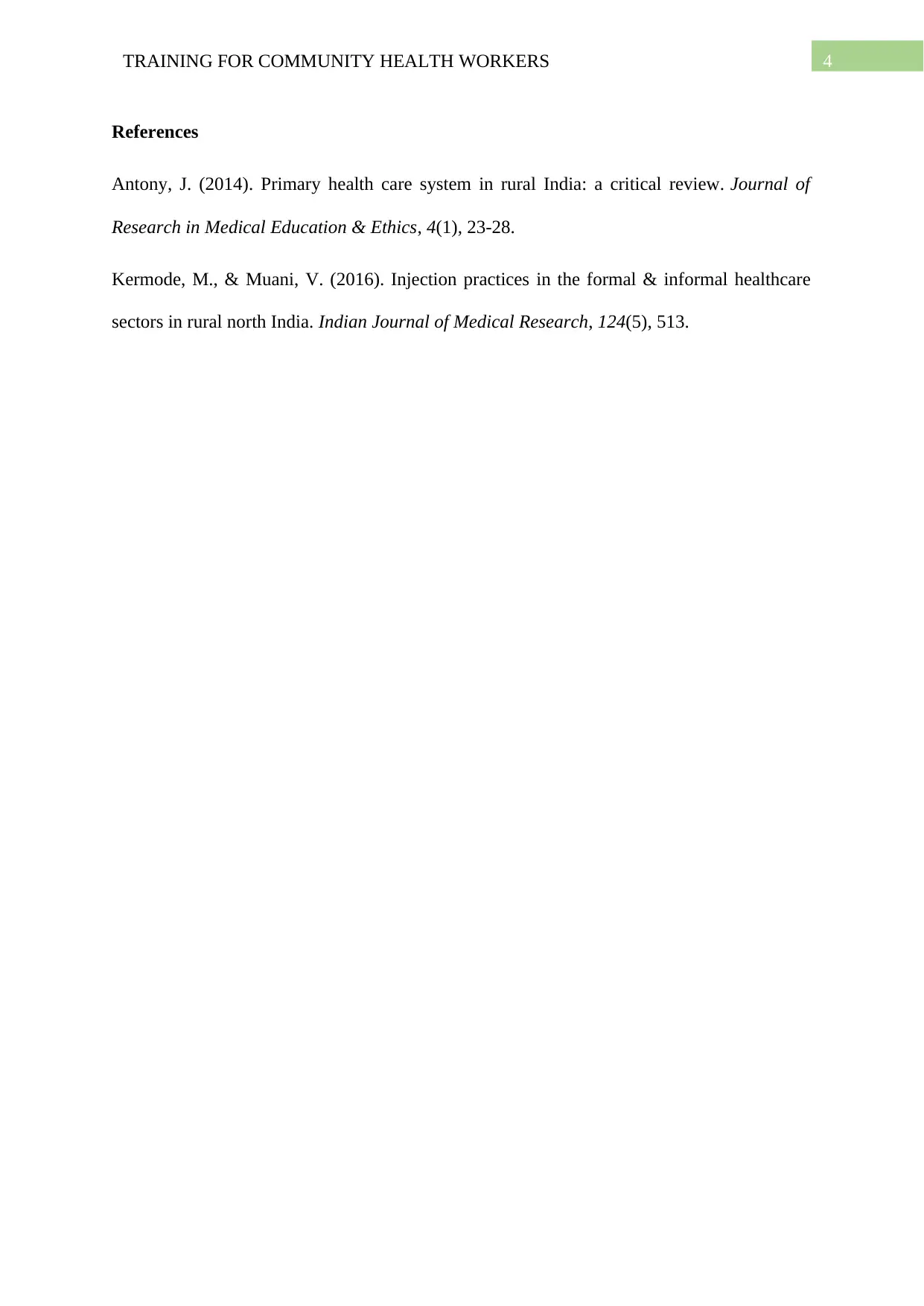
4TRAINING FOR COMMUNITY HEALTH WORKERS
References
Antony, J. (2014). Primary health care system in rural India: a critical review. Journal of
Research in Medical Education & Ethics, 4(1), 23-28.
Kermode, M., & Muani, V. (2016). Injection practices in the formal & informal healthcare
sectors in rural north India. Indian Journal of Medical Research, 124(5), 513.
References
Antony, J. (2014). Primary health care system in rural India: a critical review. Journal of
Research in Medical Education & Ethics, 4(1), 23-28.
Kermode, M., & Muani, V. (2016). Injection practices in the formal & informal healthcare
sectors in rural north India. Indian Journal of Medical Research, 124(5), 513.
1 out of 5
Related Documents
Your All-in-One AI-Powered Toolkit for Academic Success.
+13062052269
info@desklib.com
Available 24*7 on WhatsApp / Email
![[object Object]](/_next/static/media/star-bottom.7253800d.svg)
Unlock your academic potential
© 2024 | Zucol Services PVT LTD | All rights reserved.
